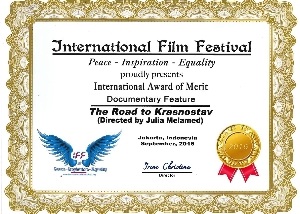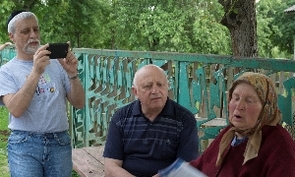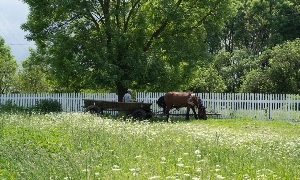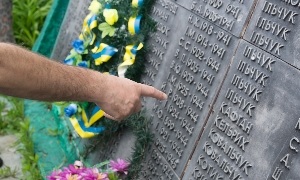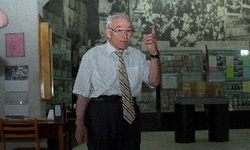About "The road to krasnostav"
Introduction
Director's statement
Traveling notes
Team
Photos
Requiem
Reviews
Introduction
|
Most people know that about 6 millions Jews were murdered in Holocaust but not so many know the story of Holocaust by Bullets happened throughout Ukraine. Krasnostav was a typical Jewish shtetl in Ukraine with 2,000 inhabitants, half of whom were Jews. Their lives ended in a way typical for Jews of Ukraine in 1941: they were killed by German Special Command and local Ukrainian collaborators in August of 1941 .
|
Jewish families, including old men, women, and children, were chased to a wooded area nearby and then shot or dumped alive into pits.
What really happened in Krasnostav in the summer of 1941?
We discovered very scant information, either documents or recollections about the annihilation of Jews of Krasnostav.
Yad Vashem’s records provide factual description of how and where the Jews of Krasnostav were killed.
In the process of our relentless research we were very fortunate to find a book “I am the Only Survivor of Krasnostav” published in 1984. The author, Donna Rubinstein, who in the beginning of World War II was a girl growing up in Krasnostav, survived the killings miraculously. Her memoirs describe a grim picture of being a Jew at that time in Ukraine. The book provides a rare and very personal emotional account of Holocaust horror.
Also we came into possession (courtesy of Leon Geyer) of a letter from Krasnostav dated 1944, which describes the murder of Reznik family in Krasnostav in 1941. The letter corroborates a story in our film in which a local woman recounts circumstances of execution style killings of Jews at the local Jewish cemetery.
The scale of Shoah is unprecedented; it was not only an attempt of total physical annihilation of millions of Jews but was also aimed at complete and utter destruction of Jewish soul, religion and culture.
Yad Vashem’s records provide factual description of how and where the Jews of Krasnostav were killed.
In the process of our relentless research we were very fortunate to find a book “I am the Only Survivor of Krasnostav” published in 1984. The author, Donna Rubinstein, who in the beginning of World War II was a girl growing up in Krasnostav, survived the killings miraculously. Her memoirs describe a grim picture of being a Jew at that time in Ukraine. The book provides a rare and very personal emotional account of Holocaust horror.
Also we came into possession (courtesy of Leon Geyer) of a letter from Krasnostav dated 1944, which describes the murder of Reznik family in Krasnostav in 1941. The letter corroborates a story in our film in which a local woman recounts circumstances of execution style killings of Jews at the local Jewish cemetery.
The scale of Shoah is unprecedented; it was not only an attempt of total physical annihilation of millions of Jews but was also aimed at complete and utter destruction of Jewish soul, religion and culture.
Director's statement
DIRECTOR'S STATEMENT BY JULIA MELAMED
|
The enigma of the Holocaust has changed society and human consciousness no less than the invention of the wheel, the discovery of America, and the French Revolution. People found out something unpleasant about themselves and their neighbors.... or did they? Do they still refuse to face the truth?
Learn more |
Traveling notes
TRAVELING NOTES BY LEONID VAYN
|
I spent the first half of my life in the USSR, being born right before World War II engulfed the Soviet territories. My father, Nathan Vaynshelboym, was drafted into the Red Army while my mother and I, a three-month old baby at the time, were evacuated on a ship slowly moving along the Volga river.
Learn more |
Team
|
Director: Julia Melamed
Camera: Julia Melamed, Igor Klyonov Editors: Julia Melamed, Igor Klyonov Photography: Leonid Vayn Sound: Alexsey Gotfrid English Subtitles: translator Leon Geyer, editor Bill Gotfrey Producers: Michael Levin, Leonid Vayn |
|
Photos
Requiem
|
|
This short multimedia feature reflects on the destruction of just one of Krasnostav families, Kaplun family, during Holocaust. Main theme of the piece is remembrance, re-connection of present and past. It was written by poet Ilya Shifrin after watching documentary “The Road to Krasnostav".
|
Reviews
“We were both deeply moved by the film. No wonder it won such a prestigious award. By focusing on a small village and a few family faces seeking the truth, the enormity of what happened across Europe comes thundering down on the viewer.
For me it was as powerful as any Holocaust museum or memorial I have ever visited”.
Kate Somers, Princeton, NJ
For me it was as powerful as any Holocaust museum or memorial I have ever visited”.
Kate Somers, Princeton, NJ
By Rabbi Goldman
“The Road to Krasnostav” review
by Rabbi Goldman, Philadelphia
April 4, 2016
It was very moving for me to watch the family's journey to their roots in Krasnostav and their attempt to recapture what life was like in the village before the Jews were brutally murdered in such a horrific way in a single day. Tragically, they learned of fellow villagers whom their relatives believed were their friends and who ended up turning against them with seemingly little resistance. Through talking to elderly people who are likely the last remaining people to remember the Jews of their village, they were able to get firsthand accounts from people who were witness to the roundup of Jews which led to their deaths.
Throughout the film, one gets a feeling of the family's deep quest to try and make sense of that which is senseless and understand the rationale of that which is beyond logic and reason. As was articulated in the film, not only did the people die, but an entire vibrant and lively culture in the village was put to death. What remains is a deafening silence amidst nature's concealment of what once was. Overgrown fields hiding tombstones of what was likely a full Jewish cemetery and barely any signs of the past to tell the story, other than a memorial at the mass grave where Jews were buried alive.
This prompts us to think hard about the flaws of the human condition and how human beings can fail miserably when it comes to making moral choices. Those who are privileged to learn of the richness of the past have an obligation to tell the story to the next generation. But even beyond telling the story, we need to help recreate the conditions of the vibrant Jewish lives which our ancestors lived and to ensure its continuity in the new world, despite the inexplicable loss of the world that was. By educating young people today to live lives of commitment to their faith, we will provide a framework for living ethical and moral lives and will ensure that ultimately, good will prevail over evil and light will prevail over darkness.
Thank you for doing your part in telling this story and I am confident that others will be inspired by this film to do their part in working to make a difference in the world.
by Rabbi Goldman, Philadelphia
April 4, 2016
It was very moving for me to watch the family's journey to their roots in Krasnostav and their attempt to recapture what life was like in the village before the Jews were brutally murdered in such a horrific way in a single day. Tragically, they learned of fellow villagers whom their relatives believed were their friends and who ended up turning against them with seemingly little resistance. Through talking to elderly people who are likely the last remaining people to remember the Jews of their village, they were able to get firsthand accounts from people who were witness to the roundup of Jews which led to their deaths.
Throughout the film, one gets a feeling of the family's deep quest to try and make sense of that which is senseless and understand the rationale of that which is beyond logic and reason. As was articulated in the film, not only did the people die, but an entire vibrant and lively culture in the village was put to death. What remains is a deafening silence amidst nature's concealment of what once was. Overgrown fields hiding tombstones of what was likely a full Jewish cemetery and barely any signs of the past to tell the story, other than a memorial at the mass grave where Jews were buried alive.
This prompts us to think hard about the flaws of the human condition and how human beings can fail miserably when it comes to making moral choices. Those who are privileged to learn of the richness of the past have an obligation to tell the story to the next generation. But even beyond telling the story, we need to help recreate the conditions of the vibrant Jewish lives which our ancestors lived and to ensure its continuity in the new world, despite the inexplicable loss of the world that was. By educating young people today to live lives of commitment to their faith, we will provide a framework for living ethical and moral lives and will ensure that ultimately, good will prevail over evil and light will prevail over darkness.
Thank you for doing your part in telling this story and I am confident that others will be inspired by this film to do their part in working to make a difference in the world.
By Ilya Abel
“Continent” internet-gazette 10.11.2015”
Reclaiming Holocaust Memories – The Authentic Way
by Ilya Abel
Translation from Russian by Leon Geyer
There are no harrowing film clips or photographs detailing the extermination of the Jews during World War II in The Road to Krasnostav documentary directed by Yulia Melamed. But there is little that remains: abandoned, overgrown graves at a Jewish cemetery, brief reminiscences of eyewitnesses who were children at the start of the war, stories that post-war children heard from their parents. On top of all that, a lingering sense of a tragedy that can’t be reconciled and defies explanation. Why did it happen in this particular Ukrainian town where the Ukrainians and the Jews had lived alongside each other for centuries only to end up as murders and victims?
Two former Soviets now living in the U.S., Michael Levin and Leo Vayn, decided to raise money to produce a documentary about one day – August 31, 1941, when around 800 Jews (almost all the Jews that remained in Krasnostav after the start of the war) were gathered at the town’s main square, led into the field, where they were shot or buried alive. Bullets were spared for the children; they were drowned in a well right before their mothers’ eyes.
An eyewitness account contained in a letter written in Ukrainian in 1944 after the town was liberated sets the stage for the film. Leonid Geyer, another new American whose relatives used to live in Krasnostav, is reading the letter.
Yulia Melamed (director), Igor Klenov (camera), and Alexei Gotfrid (sound) have actually filmed a few relatives who returned to their ancestral hometown to relive some of their ancestors’ experiences and reconstruct at least something that can still be preserved.
The ten days that the film crew and its participants spent in Ukraine – Kiev, Krasnostav – provided the material for the documentary. It’s first and foremost a documentary, an event description; artistic elements manifest themselves only through color and editing, which seems sharp at times – peaceful and tranquil Kiev (the filming was done at the end of May); same is true of Krasnostav, where the pain of those who lost their loved ones was ostensibly forgotten and life goes on.
The main question that Yulia Melamed asks herself, her audience and the subjects of the film is why this could’ve taken place, what changed in people’s psyche that allowed them to kill those who used to be their neighbors. The dialogue about what became possible on the last day of summer 1941 presents two viewpoints: the first emphasizes German initiative and sees locals in a supporting role, and the second portrays the locals as willful and cruel murderers who were merely given permission to act by the Germans.
These are not the conclusions that the director makes. The producers and those who came to see their ancestors’ hometown express both viewpoints while remaining within the boundaries of political correctness.
Here the film treads on delicate grounds, but it’s worth noting that it doesn’t put the past on trial; it merely recites the facts and collects eyewitness’ testimony.
Here are just a few facts that made it into an-hour-long film (altogether the crew accumulated 10 hours worth of recording):
Standing beside a ravine, a little girl asks an old man what’s going on. “It looks like God decided to close that book,” was his answer.
Walking through a rye field, a mother pushes her son to the side so he could hide. The boy was lying in the field for several hours, saw the returning gunmen and police officers but didn’t hear any shots. He returned home after unsuccessfully trying to dig out the people who were buried alive but was told by the neighbor to run from the place.
A man who saw a file of people being led to their deaths was desperately crying at his doorstep. Then an Ukrainian policeman approached and shot him and the others who were hiding.
A Ukrainian teacher married to a Jewish woman handed her over to the Nazis.
But this is just one part of the story. There were also others – those who saved Jews during the war. A large number of these people were Ukrainians who risked their lives and the lives of their children by hiding Jews in their cellars.
So things aren’t as simple as they may first seem.
Let me reiterate that The Road to Krasnostav doesn’t seek to condemn the perpetrators but rather to understand the origin of their inexplicable vengeance.
There was other testimony as well. An elderly woman describes the fate of her family. Most of them starved to death and sought help from the Jews who shared bread and food they had.
Another woman remembers that their village looked like a small town before the war. There were wooden sidewalks there, and people lived quite tolerably. (Nowadays, the visitor is greeted by abject poverty and desolation that throws one far back in time).
The same lady remembers that the Jews brought the Ukrainians matzoh and baked goods, and possibly even home-made wine for Jewish holidays, while the Ukrainians reciprocated with vodka and other goodies during their festivals.
In addition to remembering the past, the film is concerned with the present: restoring the cemetery and commemorating the innocent victims. True, there is a memorial to the victims of Nazism with hundreds of names engraved in the metal; there is a memorial plaque at the site of the well where the infants were thrown.
But the site of the shooting is now an empty field roamed by horses; grass is mowed and stacked there; the gravestones at the old cemetery are covered with dirt so that their Hebrew lettering is barely visible now.
Michael Levin and Leo Vayn are certain that they could raise the money to erect the monument on the site of their relatives’ death if they were sure that the money won’t just disappear but be used properly.
A tour guide to the Babi Yar memorial site is featured in the film’s opening scene. Tens of thousands Jews were killed in Babi Yar, near Kiev, day after day.
Against this backdrop, some may consider the death of Krasnostav residents less significant. But every life is priceless, and the numbers and juxtapositions don’t matter here. We are talking about the tragedy itself here, about the fact that it became possible and is now almost forgotten by all but the relatives of those killed.
After his movie The Shindlers’ List was released, Steven Spielberg donated 50 million dollars to record the stories of Holocaust survivors across the globe.
The Moscow Museum of Tolerance recorded the stories of families that maintained their Jewish identities told by people of different ages.
Michael Levin and Leo Vayn simply paid all the filming and post-production costs of the documentary that relates the Krasnostav tragedy.
Alexander Engels, the director of the Jewish Heritage and Holocaust Museum at the Moscow Memorial Synagogue, helped to organize the screening of the film, which is unlikely to have a broad release.
It wasn’t intended as an artistic statement, nor does it have a political agenda. Rather, it attempts to visually capture what could still be seen and filmed in a place that suffered an unspeakable human tragedy over a very brief period of time 74 years ago. Besides, it’s not an easy viewing – the film stirs a lot of emotion and can’t leave the audience indifferent, despite the fact that it manages to tackle the hard issues without resorting to heart-rending video materials commonly used in such cases.
But such documentaries have to be made and watched, lest we forget. It shouldn’t be done out of hatred but rather to get a feel for the fate of one’s own people that is shared through both holy and mundane, through its pain and suffering.
I also wanted to watch The Road to Krasnostav for a deeply personal reason. My mother’s family hails from the Ukrainian town of Yampol (perhaps, the modern map of Ukraine still features this name, but its past inhabitants are long gone, wiped out with the start of German occupation; the war caught up with my mother of blessed memory in Moscow, where she received notices on the deaths of her three brothers, my uncles).
Obviously, I’ll never get to go to Yampol. So the Krasnostav that was shown in the film, the town the way it was at the outset of the war, conjured up the images of Yampol for me, images of something that no longer exits and will probably never exist anymore, since I can still retain the ashes and the pain of loss in my memory. It would probably be too hard for me to go there. I can clearly imagine the life there from my mom’s stories – two synagogues, a school, orchards, Jews living alongside Ukrainians – but it would be difficult for me to relive what happened there during the war.
That’s what makes Michael Levin’s and Leo Vayn’s effort so important. They found strength and courage to retrace the steps of their relatives’ execution and thus remind us that the town did perish, and it’s not merely a piece of history but an event that can’t be blotted out of one’s consciousness and forgotten regardless of the time and space that separates us from it.
Thus, we should be very grateful to the producers of The Road to Krasnostav and its Russian-Ukrainian production team for making this screening possible a year after the idea to create such a documentary first emerged. Now it has already staked out a place in Moscow’s cultural life, although it has not received all the recognition it rightfully deserves by virtue of the fact that, just as stated in the film, it appeals to virtually anyone regardless of religion and ethnic origin.
Reclaiming Holocaust Memories – The Authentic Way
by Ilya Abel
Translation from Russian by Leon Geyer
There are no harrowing film clips or photographs detailing the extermination of the Jews during World War II in The Road to Krasnostav documentary directed by Yulia Melamed. But there is little that remains: abandoned, overgrown graves at a Jewish cemetery, brief reminiscences of eyewitnesses who were children at the start of the war, stories that post-war children heard from their parents. On top of all that, a lingering sense of a tragedy that can’t be reconciled and defies explanation. Why did it happen in this particular Ukrainian town where the Ukrainians and the Jews had lived alongside each other for centuries only to end up as murders and victims?
Two former Soviets now living in the U.S., Michael Levin and Leo Vayn, decided to raise money to produce a documentary about one day – August 31, 1941, when around 800 Jews (almost all the Jews that remained in Krasnostav after the start of the war) were gathered at the town’s main square, led into the field, where they were shot or buried alive. Bullets were spared for the children; they were drowned in a well right before their mothers’ eyes.
An eyewitness account contained in a letter written in Ukrainian in 1944 after the town was liberated sets the stage for the film. Leonid Geyer, another new American whose relatives used to live in Krasnostav, is reading the letter.
Yulia Melamed (director), Igor Klenov (camera), and Alexei Gotfrid (sound) have actually filmed a few relatives who returned to their ancestral hometown to relive some of their ancestors’ experiences and reconstruct at least something that can still be preserved.
The ten days that the film crew and its participants spent in Ukraine – Kiev, Krasnostav – provided the material for the documentary. It’s first and foremost a documentary, an event description; artistic elements manifest themselves only through color and editing, which seems sharp at times – peaceful and tranquil Kiev (the filming was done at the end of May); same is true of Krasnostav, where the pain of those who lost their loved ones was ostensibly forgotten and life goes on.
The main question that Yulia Melamed asks herself, her audience and the subjects of the film is why this could’ve taken place, what changed in people’s psyche that allowed them to kill those who used to be their neighbors. The dialogue about what became possible on the last day of summer 1941 presents two viewpoints: the first emphasizes German initiative and sees locals in a supporting role, and the second portrays the locals as willful and cruel murderers who were merely given permission to act by the Germans.
These are not the conclusions that the director makes. The producers and those who came to see their ancestors’ hometown express both viewpoints while remaining within the boundaries of political correctness.
Here the film treads on delicate grounds, but it’s worth noting that it doesn’t put the past on trial; it merely recites the facts and collects eyewitness’ testimony.
Here are just a few facts that made it into an-hour-long film (altogether the crew accumulated 10 hours worth of recording):
Standing beside a ravine, a little girl asks an old man what’s going on. “It looks like God decided to close that book,” was his answer.
Walking through a rye field, a mother pushes her son to the side so he could hide. The boy was lying in the field for several hours, saw the returning gunmen and police officers but didn’t hear any shots. He returned home after unsuccessfully trying to dig out the people who were buried alive but was told by the neighbor to run from the place.
A man who saw a file of people being led to their deaths was desperately crying at his doorstep. Then an Ukrainian policeman approached and shot him and the others who were hiding.
A Ukrainian teacher married to a Jewish woman handed her over to the Nazis.
But this is just one part of the story. There were also others – those who saved Jews during the war. A large number of these people were Ukrainians who risked their lives and the lives of their children by hiding Jews in their cellars.
So things aren’t as simple as they may first seem.
Let me reiterate that The Road to Krasnostav doesn’t seek to condemn the perpetrators but rather to understand the origin of their inexplicable vengeance.
There was other testimony as well. An elderly woman describes the fate of her family. Most of them starved to death and sought help from the Jews who shared bread and food they had.
Another woman remembers that their village looked like a small town before the war. There were wooden sidewalks there, and people lived quite tolerably. (Nowadays, the visitor is greeted by abject poverty and desolation that throws one far back in time).
The same lady remembers that the Jews brought the Ukrainians matzoh and baked goods, and possibly even home-made wine for Jewish holidays, while the Ukrainians reciprocated with vodka and other goodies during their festivals.
In addition to remembering the past, the film is concerned with the present: restoring the cemetery and commemorating the innocent victims. True, there is a memorial to the victims of Nazism with hundreds of names engraved in the metal; there is a memorial plaque at the site of the well where the infants were thrown.
But the site of the shooting is now an empty field roamed by horses; grass is mowed and stacked there; the gravestones at the old cemetery are covered with dirt so that their Hebrew lettering is barely visible now.
Michael Levin and Leo Vayn are certain that they could raise the money to erect the monument on the site of their relatives’ death if they were sure that the money won’t just disappear but be used properly.
A tour guide to the Babi Yar memorial site is featured in the film’s opening scene. Tens of thousands Jews were killed in Babi Yar, near Kiev, day after day.
Against this backdrop, some may consider the death of Krasnostav residents less significant. But every life is priceless, and the numbers and juxtapositions don’t matter here. We are talking about the tragedy itself here, about the fact that it became possible and is now almost forgotten by all but the relatives of those killed.
After his movie The Shindlers’ List was released, Steven Spielberg donated 50 million dollars to record the stories of Holocaust survivors across the globe.
The Moscow Museum of Tolerance recorded the stories of families that maintained their Jewish identities told by people of different ages.
Michael Levin and Leo Vayn simply paid all the filming and post-production costs of the documentary that relates the Krasnostav tragedy.
Alexander Engels, the director of the Jewish Heritage and Holocaust Museum at the Moscow Memorial Synagogue, helped to organize the screening of the film, which is unlikely to have a broad release.
It wasn’t intended as an artistic statement, nor does it have a political agenda. Rather, it attempts to visually capture what could still be seen and filmed in a place that suffered an unspeakable human tragedy over a very brief period of time 74 years ago. Besides, it’s not an easy viewing – the film stirs a lot of emotion and can’t leave the audience indifferent, despite the fact that it manages to tackle the hard issues without resorting to heart-rending video materials commonly used in such cases.
But such documentaries have to be made and watched, lest we forget. It shouldn’t be done out of hatred but rather to get a feel for the fate of one’s own people that is shared through both holy and mundane, through its pain and suffering.
I also wanted to watch The Road to Krasnostav for a deeply personal reason. My mother’s family hails from the Ukrainian town of Yampol (perhaps, the modern map of Ukraine still features this name, but its past inhabitants are long gone, wiped out with the start of German occupation; the war caught up with my mother of blessed memory in Moscow, where she received notices on the deaths of her three brothers, my uncles).
Obviously, I’ll never get to go to Yampol. So the Krasnostav that was shown in the film, the town the way it was at the outset of the war, conjured up the images of Yampol for me, images of something that no longer exits and will probably never exist anymore, since I can still retain the ashes and the pain of loss in my memory. It would probably be too hard for me to go there. I can clearly imagine the life there from my mom’s stories – two synagogues, a school, orchards, Jews living alongside Ukrainians – but it would be difficult for me to relive what happened there during the war.
That’s what makes Michael Levin’s and Leo Vayn’s effort so important. They found strength and courage to retrace the steps of their relatives’ execution and thus remind us that the town did perish, and it’s not merely a piece of history but an event that can’t be blotted out of one’s consciousness and forgotten regardless of the time and space that separates us from it.
Thus, we should be very grateful to the producers of The Road to Krasnostav and its Russian-Ukrainian production team for making this screening possible a year after the idea to create such a documentary first emerged. Now it has already staked out a place in Moscow’s cultural life, although it has not received all the recognition it rightfully deserves by virtue of the fact that, just as stated in the film, it appeals to virtually anyone regardless of religion and ethnic origin.
By Igor Mandel (Russian)
By Lyudmila Lapshina
I have visited Auschwitz in Poland and Yad Vashem Holocaust Memorial in Jerusalem. What can I say? Horror, pain and sorrow I felt were overwhelming. But what stands out in my memory is my visit to Babiy Yar in Kiev, Ukraine, with my Grandpa’s brother in 1971. There was no Holocaust memorial at the site of massacre at that time. In my mind’s eye I can still see him, the elderly Jewish man crippled in the battles of WW II, supporting himself with a cane, every step was a big effort, and the same cane touching the hill of earth, and his desperate words, “ here, and here and there… , these are the remains of the 34 thousand innocent people”. My heart was broken. Because of my Uncle Yudel , who might have perished in Babi Yar, had not he had been in the army, that visit became a very intimate experience.
I felt the same way watching the documentary “The Road to Krasnostav”. It is a fact that the film is a historical account of the actual events. But it gives you a sense of a personal contact with that reality because the main characters who are seeking that reality are alive, they are real: they are saying Mourner’s Kaddish at the overgrown graves at a Jewish cemetery and at the water well in which the Nazis drowned every Jewish baby of the village, they are talking to the witnesses of the tragedy…The camera captures a whole range of their emotions: horror, disbelieve, despair, determination.
The film makers were driven by a desire to pay homage to their ancestors. But the film actually became a tribute to all victims of the“Holocaust by Bullets” in Ukraine (June 1941 till January 1942)
As a result, a private documentary has evolved into a documentary of universal significance, which according to Stephen Somers , PhD ( PhD in politics of education), “is an enormous Mitzvah and one should be in the hands of history, political science, international relations and religion departments the world over. And in the minds of State Departments the world over as well”.
What makes me such a strong advocate of this documentary?
First: “You should not stand idly by the blood of your neighbor” (Vayikra 19:16).
Second: it is a very powerful documentary on a universally acknowledged problem (see UNGA Resolution on the Holocaust Remembrance A/RES/60/7 of November 1, 2005) .
It must be brought to the public notice and find a broader audience.
I felt the same way watching the documentary “The Road to Krasnostav”. It is a fact that the film is a historical account of the actual events. But it gives you a sense of a personal contact with that reality because the main characters who are seeking that reality are alive, they are real: they are saying Mourner’s Kaddish at the overgrown graves at a Jewish cemetery and at the water well in which the Nazis drowned every Jewish baby of the village, they are talking to the witnesses of the tragedy…The camera captures a whole range of their emotions: horror, disbelieve, despair, determination.
The film makers were driven by a desire to pay homage to their ancestors. But the film actually became a tribute to all victims of the“Holocaust by Bullets” in Ukraine (June 1941 till January 1942)
As a result, a private documentary has evolved into a documentary of universal significance, which according to Stephen Somers , PhD ( PhD in politics of education), “is an enormous Mitzvah and one should be in the hands of history, political science, international relations and religion departments the world over. And in the minds of State Departments the world over as well”.
What makes me such a strong advocate of this documentary?
First: “You should not stand idly by the blood of your neighbor” (Vayikra 19:16).
Second: it is a very powerful documentary on a universally acknowledged problem (see UNGA Resolution on the Holocaust Remembrance A/RES/60/7 of November 1, 2005) .
It must be brought to the public notice and find a broader audience.
List of screening events
International Film Festival For Peace, Inspiration and Equality in Jakarta, Indonesia (the film received International Award of Merit at 2016 IFFPIE);
Jewish Museum and Center of Tolerance in Moscow, Russian Federation;
Yad Vashem Video Library, Israel;
The Jewish Community Center in Manhattan, NY;
Limmud Conference, NY
Temple B’nai Torah, Bellevue, WA;
B’nai Abraham Chabad, Philadelphia, PA;
Dalet Concerts, Princeton, NJ
Jewish Museum and Center of Tolerance in Moscow, Russian Federation;
Yad Vashem Video Library, Israel;
The Jewish Community Center in Manhattan, NY;
Limmud Conference, NY
Temple B’nai Torah, Bellevue, WA;
B’nai Abraham Chabad, Philadelphia, PA;
Dalet Concerts, Princeton, NJ
Watch this documentary

